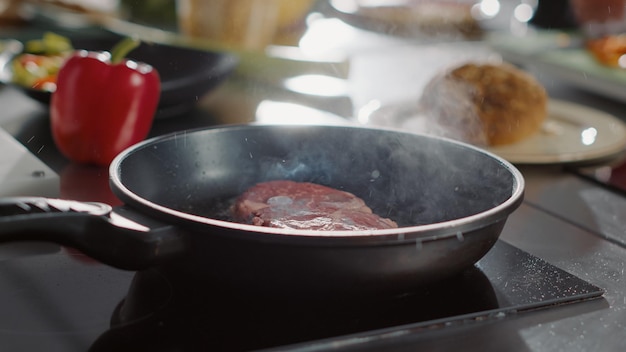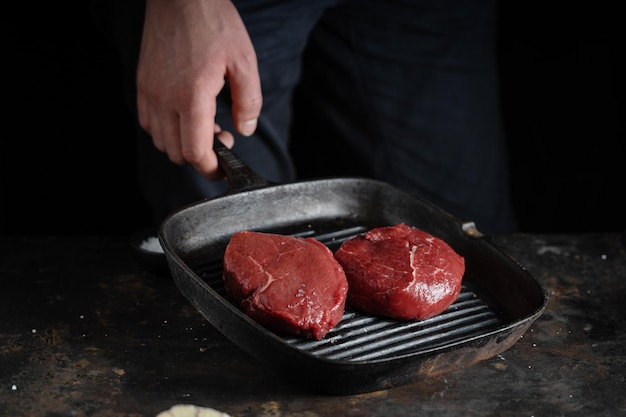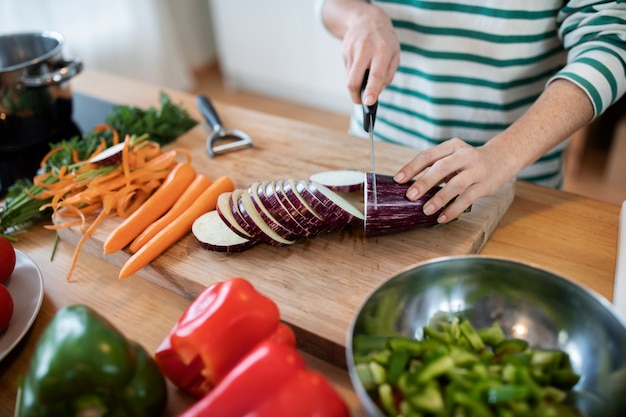Let's be honest, cooking can feel a bit overwhelming sometimes. There's all this talk about exact temperatures, fancy gadgets, and a whole vocabulary dedicated to kitchen techniques. But you know what? Cooking should be enjoyable, not stressful. And that's where flank steak comes in. It's a cut of beef that's full of flavour and incredibly forgiving, even for a seasoned cook like myself. You don't need a thermometer to get it just right, just a little bit of know-how and a dash of confidence.
I've been cooking for years, and I've always believed in the power of intuition in the kitchen. Yes, thermometers have their place, but sometimes, the best way to cook is by feel, by understanding the texture of the meat, and by trusting your instincts. So, ditch the gadget and let's explore the world of cooking flank steak the old-fashioned way, the way it was meant to be done.
Part 1: Setting the Stage for Flank Steak Success

Before we dive into the cooking process, let's make sure we're armed with everything we need. You'll want a nice, thick piece of flank steak, about 1.5kg will do the trick.
Choosing the Right Flank Steak
Now, when it comes to picking the perfect flank steak, look for one with a good marbling. You know, those beautiful streaks of fat that run throughout the meat. They're like little flavour bombs, ensuring your steak is juicy, tender, and bursting with deliciousness. Don't hesitate to ask your butcher for advice. They're the experts, and they'll be happy to guide you toward the best cut for your needs.
Essential Tools: The Kitchen Arsenal
Alright, you've got your steak, now let's gather our trusty kitchen companions. You'll need:
- A sharp knife: This is your weapon of choice for precise slicing and ensuring a clean cut.
- A cutting board: A sturdy surface to protect your counter and provide a stable foundation for your culinary maneuvers.
- A large pan, preferably cast iron: Cast iron retains heat beautifully, guaranteeing a perfect sear. If you don't have one, a heavy-bottomed pan will do the trick.
- A wooden spoon: Perfect for stirring and ensuring even cooking.
- A kitchen towel: For patting the steak dry, ensuring a crisp crust.
- Salt and pepper: The foundation of any good seasoning, adding depth and enhancing the steak's natural flavor.
With this arsenal, you're ready to tackle any culinary challenge!
Part 2: Prepping the Flank Steak: A Taste of Magic

Now, this is where the real magic happens. Grab your steak and give it a good pat dry with that kitchen towel. We want to make sure it's nice and dry before we start cooking. This ensures a beautiful, crisp sear that locks in the flavour and prevents any unwanted steam. You can choose to slice the steak into thin strips now, or you can wait and slice it after cooking. It's all a matter of preference. Personally, I find slicing after cooking makes portioning easier and prevents the steak from becoming too dry.
Seasoning the Steak: A Symphony of Flavors
Time to give this steak the flavour boost it deserves! A simple sprinkle of salt and pepper is all you really need, but hey, you're the artist here! Feel free to experiment and let your creative juices flow. Try adding a touch of paprika for a smoky depth, some garlic powder for an aromatic punch, or even a little bit of chili flakes for a spicy kick. The key is to enhance the steak's natural flavour, not mask it.
Marinating the Steak: A Flavour Infusion
Now, marinating is a completely optional step, but I always like to give my flank steak a little extra love. It's like a spa treatment for your meat, adding an extra layer of flavor and helping to tenderize those tough muscle fibers. My go-to marinade is a simple mix of olive oil, lemon juice, and a few herbs like rosemary or thyme. Let it sit in the marinade for at least an hour, but overnight is even better, allowing the flavors to really meld. You can find endless marinade recipes online, so get creative and experiment!
Part 3: Cooking the Flank Steak: A Masterclass in Intuition

Here's where things get really exciting! It's time to cook our steak. We're going for that perfect medium-rare finish, that beautiful, juicy interior with a nice sear on the outside. Forget the thermometer, this is about trust and intuition.
Searing the Steak: The Foundation of Flavor
Fire up your pan over high heat. You want it nice and hot, almost smoking. Now, carefully add your flank steak to the pan. Don't overcrowd the pan, you want to make sure each piece has plenty of space to get that glorious sear. Give it a couple of minutes on each side, until it develops that gorgeous golden-brown crust. That's the magic of the sear, locking in the juices and creating a symphony of textures.
Reducing the Heat: A Gradual Transition
Once you've got your beautiful sear, it's time to turn down the heat a bit. Let's bring it down to medium-high heat. You're looking for a temperature where you can still see a little bit of sizzle in the pan, but not enough to burn the steak. This is where we start to cook the meat through, creating that beautiful pink center we're aiming for.
Cooking to Perfection: Mastering the Visual Cues
Now, this is where your instincts come into play. You want to cook the steak for another 4-5 minutes on each side, depending on how thick it is. But, here's the key: you want to pay attention to the color of the steak. As it cooks, it will change color from a deep red to a pinker hue. Remember, we're aiming for medium-rare, so you're looking for a light pink color in the center of the steak. It's like watching a culinary masterpiece unfold right before your eyes.
Part 4: Resting the Steak: A Moment of Indulgence
Alright, we're almost there! You've cooked your steak to perfection, now it's time for the final step: resting. This might seem like an unnecessary step, but trust me, it's crucial. When you rest the steak, the juices redistribute throughout the meat, making it even more tender and juicy. It's a moment of relaxation for the steak, allowing the flavours to settle and deepen.
How Long to Rest: The Art of Patience
Let the steak rest for about 10 minutes before slicing. This might seem like a long time, but it's worth it. Cover the steak loosely with a piece of foil while it rests. This creates a warm, humid environment that helps to keep the steak moist and tender.
Slicing the Steak: A Culinary Symphony
Now, it's time to slice! Use your sharp knife to cut the flank steak across the grain. This is important because it makes the steak easier to chew and prevents it from being tough. Imagine each bite as a little symphony of flavours and textures, all thanks to the careful slicing.
Part 5: Serving the Flank Steak: A Culinary Canvas
Okay, your steak is cooked, rested, and sliced. Now it's time to serve it up. The possibilities are endless, so get ready to unleash your culinary creativity!
Serving Suggestions: A Palette of Possibilities
The beauty of flank steak is that it's incredibly versatile. Here are a few ideas to get you started, but feel free to explore your own culinary adventures:
- Serve it with a simple salad, like a Greek salad with tangy feta cheese and juicy tomatoes, or a Caprese salad with fresh mozzarella and basil.
- Make a delicious steak sandwich with your favorite toppings, like caramelized onions, sharp cheddar cheese, and a tangy mustard.
- Toss it with pasta and your favorite sauce for a quick and easy meal. A hearty tomato sauce or a creamy pesto sauce would pair beautifully.
- Slice it and serve it over a bed of rice for a flavorful and satisfying dinner. Add a side of steamed vegetables for a complete meal.
- Try grilling the flank steak and serving it with a chimichurri sauce. The smoky char of the grill and the vibrant, herbaceous flavors of chimichurri are a perfect match.
Remember, the beauty of cooking is in the experimentation. So, don't be afraid to try new things, to mix and match flavors, and to create dishes that speak to your unique taste buds.
Part 6: Flank Steak Cooking Time: A Visual Guide
You might be wondering, how do you know when it's done without a thermometer? It's simple, just remember this table, and you'll be a flank steak pro in no time!
| Cooking Time | Steak Colour | steak doneness |
|---|---|---|
| 4-5 minutes per side (medium-rare) | Light pink center | Juicy and tender |
| 6-7 minutes per side (medium) | Pink throughout | Slightly firmer texture |
| 8-9 minutes per side (medium-well) | Very little pink | Firmer texture |
| 10 minutes per side (well-done) | No pink | Tough and dry |
Of course, you can always adjust the cooking time depending on the thickness of your steak and the heat of your pan. The key is to keep a watchful eye on the colour of the steak and to trust your instincts.
Part 7: Common Mistakes and Troubleshooting: A Culinary First Aid Kit
We all make mistakes, and cooking flank steak is no exception. But don't worry, we can fix any hiccups!
Overcooked Steak: A Culinary Remedy
If your steak is overcooked, it will be tough and dry. The good news is, there's not much you can do about it once it's overcooked. However, you can try to salvage it by slicing it thinly and using it in a recipe where it can be rehydrated, like a stir-fry.
Undercooked Steak: A Few Extra Minutes
If your steak is undercooked, it will be pink inside. You can cook it further on the stovetop, but it might become tougher. To avoid this, always check your steak for doneness by poking it with a fork. If the juices run clear, it's cooked through. If they're still red, it needs more cooking.
Tough Steak: Prevention is Key
If your steak is tough, it's likely because it was overcooked. To prevent this, cook it for a shorter amount of time and use a marinade to help tenderize it.
Dry Steak: The Importance of Moisture
If your steak is dry, it's likely because it was overcooked. To prevent this, cook it for a shorter amount of time and use a marinade to help retain moisture.
Part 8: Variations and Substitutions: A Culinary Playground
Want to try something different? Here are a few variations and substitutions for flank steak.
Marinade: A Flavor Explosion
Experiment with different marinades, like soy sauce, ginger, and garlic for a savory Asian-inspired flavor, or lime juice, cilantro, and cumin for a vibrant Mexican-inspired taste.
Seasoning: A Spice Symphony
Use a variety of seasonings, such as paprika for a smoky depth, garlic powder and onion powder for a savory aroma, or chili powder for a kick.
Cooking Method: Beyond the Pan
Try grilling, broiling, or pan-frying your flank steak. Each method will yield different textures and flavors, allowing you to explore the versatility of this incredible cut of beef.
Part 9: FAQs: A Guide to Flank Steak Success
Here are a few common questions about cooking flank steak.
1. Can I use a different cut of beef for this recipe?
Yes, you can use a different cut of beef, such as skirt steak or top sirloin. Just be sure to adjust the cooking time accordingly, as they might cook at a slightly different rate.
2. How do I know if my flank steak is cooked to the right temperature without a thermometer?
You can check the doneness of your flank steak by pressing on it with your finger. If it feels firm and springy, it's medium-rare. If it feels a little firmer, it's medium. If it feels very firm, it's medium-well or well-done. Remember, the key is to pay attention to the color of the steak and to trust your instincts.
3. What should I do with the leftover flank steak?
You can slice the leftover flank steak thinly and use it in a stir-fry, salad, or sandwich. It's also delicious cold, so you can make a few sandwiches for lunch!
4. Can I freeze flank steak?
Yes, you can freeze flank steak for up to 3 months. Make sure to wrap it tightly in plastic wrap or aluminum foil before freezing. This helps prevent freezer burn and keeps the steak fresh and flavorful.
5. What are some good side dishes to serve with flank steak?
Some good side dishes for flank steak include mashed potatoes for a comforting touch, roasted vegetables for a vibrant and flavorful complement, or a salad for a fresh and light counterpoint.
Part 10: Conclusion: Embrace the Journey of Flavor
There you have it, you're now a flank steak master! Remember, the key is to trust your instincts, be patient, and have fun. Don't be afraid to experiment and find what you love best. After all, the journey of flavor is just as important as the destination. So, grab your flank steak, unleash your creativity, and enjoy the delicious rewards!
Everyone is watching

How to Cook Frozen Lobster Tails Perfectly: A Step-by-Step Guide
RecipesLobster. Just the word conjures up images of lavish meals, special occasions, and a taste of luxury. But let's...

Pork Fillet Cooking Time: How Long to Cook It Perfectly
RecipesPork fillet, or tenderloin as it's sometimes called, is a real favourite in our house. It's so versatile, and...

Pigs in a Blanket Cooking Time: How Long to Bake for Perfect Results
RecipesAh, pigs in a blanket. Just the name conjures up images of those delightful little parcels of crispy pastry en...

The Ultimate Guide to Cooking Delicious Frankfurters
RecipesLet's face it, we all love a good frankfurter. It's a classic, simple, and always satisfying. But let's be rea...

Wolf Meat Recipes: A Guide to Cooking Wild Game
RecipesLet's be honest, you don't see wolf meat at your local butcher shop every day. It's a bit of a wild card, but ...
